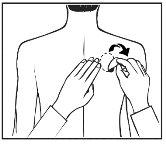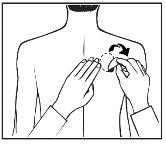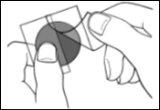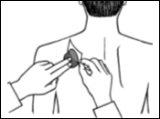
ПРОМЕТАКС 9,5 мг/24 ч ТРАНСДЕРМАЛЬНЫЙ ПЛАСТЫРЬ

Инструкция по применению ПРОМЕТАКС 9,5 мг/24 ч ТРАНСДЕРМАЛЬНЫЙ ПЛАСТЫРЬ
Введение
Инструкция: информация для пользователя
Прометакс 4,6мг/24ч трансдермальный пластырь
Прометакс 9,5мг/24ч трансдермальный пластырь
Прометакс 13,3мг/24ч трансдермальный пластырь
ривастигмина
Прочитайте внимательно всю инструкцию перед началом использования этого лекарства, поскольку она содержит важную информацию для вас.
- Сохраните эту инструкцию, поскольку вам может потребоваться прочитать ее снова.
- Если у вас есть какие-либо вопросы, проконсультируйтесь с вашим врачом, фармацевтом или медсестрой.
- Это лекарство было назначено только вам, и не следует давать его другим людям, даже если у них такие же симптомы, как у вас, поскольку оно может нанести им вред.
- Если вы испытываете побочные эффекты, проконсультируйтесь с вашим врачом, фармацевтом или медсестрой, даже если это побочные эффекты, которые не указаны в этой инструкции. См. раздел 4.
Содержание инструкции
- Что такое Прометакс и для чего он используется
- Что вам нужно знать перед началом использования Прометакса
- Как использовать Прометакс
- Возможные побочные эффекты
- Хранение Прометакса
- Содержание упаковки и дополнительная информация
1. Что такое Прометакс и для чего он используется
Активным веществом Прометакса является ривастигмина.
Ривастигмина относится к группе ингибиторов холинэстеразы. У пациентов с деменцией Альцгеймера определенные нервные клетки умирают в мозге, что приводит к низким уровням нейротрансмиттеров ацетилхолина (вещества, которая позволяет нервным клеткам общаться друг с другом). Ривастигмина действует, блокируя ферменты, которые разрушают ацетилхолин: ацетилхолинэстеразу и бутирилхолинэстеразу. Блокируя эти ферменты, Прометакс позволяет увеличить уровень ацетилхолина в мозге, что помогает уменьшить симптомы болезни Альцгеймера.
Прометакс используется для лечения пациентов с деменцией Альцгеймера легкой или умеренной степени, прогрессивного расстройства мозга, которое постепенно влияет на память, интеллектуальные способности и поведение.
2. Что вам нужно знать перед началом использования Прометакса
Не используйте Прометакс
- если вы аллергичны к ривастигмине (активному веществу Прометакса) или к любому другому компоненту этого лекарства (указанному в разделе 6).
- если у вас когда-либо была аллергическая реакция на лекарство, подобное ривастигмине (производные карбамата).
- если у вас есть кожная реакция, которая распространяется за пределы размера пластыря, если есть местная реакция более сильная (такая как пузыри, увеличение воспаления кожи) и если нет улучшения в течение 48 часов после удаления трансдермального пластыря.
Если вы находитесь в одной из этих ситуаций, сообщите об этом вашему врачу и не используйте Прометакс трансдермальные пластыри.
Предостережения и меры предосторожности
Проконсультируйтесь с вашим врачом перед началом использования Прометакса:
- если у вас есть или были проблемы с сердцем, такие как нерегулярный или медленный сердечный ритм, удлинение интервала QTc, семейная история удлинения интервала QTc, torsade de pointes или если у вас низкий уровень калия или магния в крови.
- если у вас есть или были язвы желудка.
- если у вас есть или были проблемы с мочеиспусканием.
- если у вас есть или были судороги.
- если у вас есть или были тяжелые респираторные заболевания.
- если у вас есть тремор.
- если у вас низкий вес.
- если у вас есть желудочно-кишечные реакции, такие как тошнота, рвота и диарея. Вы можете обезвожиться (потерять большое количество жидкости), если рвота или диарея продолжаются.
- если у вас есть проблемы с печенью (печеночная недостаточность).
Если вы находитесь в одной из этих ситуаций, ваш врач может считать необходимым более тщательно наблюдать за вами во время лечения.
Если вы не использовали пластыри более трех дней, не накладывайте новый без предварительной консультации с вашим врачом.
Дети и подростки
Прометакс не должен использоваться у детей и подростков для лечения болезни Альцгеймера.
Другие лекарства и Прометакс
Сообщите вашему врачу или фармацевту, если вы принимаете, недавно принимали или можете принимать любое другое лекарство.
Прометакс может взаимодействовать с антихолинergicными лекарствами, некоторые из которых используются для облегчения спазмов или судорог желудка (например, дцикломин), для лечения болезни Паркинсона (например, амантадин) или для предотвращения укачивания (например, дифенгидрамин, скополамин или меклизин).
Прометакс трансдермальные пластыри не должны применяться одновременно с метоклопрамидом (лекарством, используемым для облегчения или предотвращения тошноты и рвоты). Одновременное применение этих двух лекарств может вызвать проблемы, такие как жесткость в конечностях и тремор рук.
Если вам необходимо пройти хирургическую операцию во время использования Прометакса трансдермальных пластырей, сообщите вашему врачу, что вы используете его, поскольку он может чрезмерно усилить эффекты некоторых миорелаксантов анестезии.
Следует проявлять осторожность при использовании Прометакса трансдермальных пластырей вместе с бета-блокаторами (лекарствами, такими как атенолол, используемыми для лечения гипертонии, стенокардии и других сердечных заболеваний). Одновременное применение этих двух лекарств может вызвать осложнения, такие как снижение частоты сердечных сокращений (брадикардия), что может привести к обмороку или потере сознания.
Следует проявлять осторожность при использовании Прометакса вместе с другими лекарствами, которые могут влиять на сердечный ритм или электрическую систему сердца (удлинение интервала QT).
Беременность, лактация и фертильность
Если вы беременны или кормите грудью, считаете, что можете быть беременной или планируете стать беременной, проконсультируйтесь с вашим врачом или фармацевтом перед использованием этого лекарства.
Если вы беременны, необходимо оценить преимущества использования Прометакса по сравнению с возможными побочными эффектами для плода. Прометакс не должен использоваться во время беременности, если только это не абсолютно необходимо.
Не следует кормить грудью во время лечения Прометаксом трансдермальными пластырями.
Вождение и использование машин
Ваш врач сообщит вам, позволяет ли ваше состояние вождению или использованию машин безопасно. Прометакс трансдермальные пластыри могут вызывать головокружение и сильную дезориентацию. Если вы чувствуете головокружение или дезориентацию, не驾ьте транспортные средства, не используйте машины и не выполняйте другие задачи, требующие вашего внимания.
3. Как использовать Прометакс
Следуйте точно инструкциям по применению Прометакса трансдермальных пластырей, указанным вашим врачом. В случае сомнений проконсультируйтесь с вашим врачом, фармацевтом или медсестрой.
ВАЖНО:
- Удалите предыдущий пластырь перед применением НОВОГО пластыря.
- Только один пластырь в день.
- Не разрезайте пластырь на части.
- Примените пластырь к коже и прижмите его плотно ладонью не менее 30 секунд.
Как начать лечение
Ваш врач укажет вам наиболее подходящую дозу Прометакса трансдермального пластыря для вашего случая.
- Обычно лечение начинается с Прометакса 4,6 мг/24 ч.
- Рекомендуемая ежедневная доза составляет Прометакс 9,5 мг/24 ч. Если эта доза хорошо переносится, ваш врач может рассмотреть возможность увеличения дозы до 13,3 мг/24 ч.
- Носите только один Прометакс пластырь одновременно и замените его новым пластырем через 24 часа.
Во время лечения ваш врач может корректировать дозу в зависимости от ваших индивидуальных потребностей.
Если вы не использовали пластыри более трех дней, не накладывайте новый без предварительной консультации с вашим врачом. Лечение трансдермальным пластырем можно возобновить в той же дозе, если лечение не было прервано более чем на три дня. В противном случае ваш врач может назначить вам начать лечение с Прометаксом 4,6 мг/24 ч.
Прометакс можно использовать с пищей, напитками и алкоголем.
Где применить Прометакс трансдермальный пластырь
- Перед применением пластыря убедитесь, что кожа чистая, сухая и без волос, без порошков, масла, увлажнителя или лосьона, которые могут препятствовать приклеиванию пластыря к коже, без порезов, покраснений или раздражений.
- Аккуратно удалите любой предыдущий пластырь перед применением нового.Ношение нескольких пластырей на вашем теле может привести к чрезмерному воздействию этого лекарства и быть потенциально опасным.
- Примените только ОДИНпластырь в день в ОДНОЙиз возможных зон, как показано на следующих схемах:
- верхняя левая иливерхняя правая часть руки
- верхняя левая иливерхняя правая часть груди (избегая груди у женщин)
- верхняя левая иливерхняя правая часть спины
- нижняя левая илинижняя правая часть спины
Каждые 24часа удалите предыдущий пластырь перед применением НОВОГО пластыря в ОДНОЙ из следующих возможных зон. |
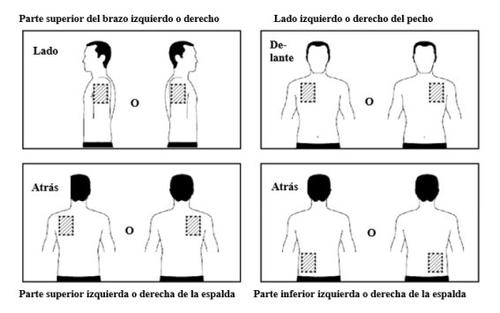
Каждый раз, когда вы меняете пластырь, удалите предыдущий пластырь до применения нового пластыря в другом месте на коже (например, один день на правой стороне тела и на следующий день на левой стороне; или один день на верхней части тела и на следующий день на нижней части). Подождите не менее 14 дней, прежде чем применить новый пластырь в том же месте на коже.
Какприменить Прометакс трансдермальный пластырь
Пластыри Прометакса тонкие, плоские и непрозрачные и приклеиваются к коже. Каждый пластырь находится в отдельном пакете, который защищает его до применения. Не открывайте пакет и не удаляйте пластырь до момента применения.
|
|
Откройте пакет только перед применением пластыря. Разрежьте пакет по линии точки с помощью ножниц и удалите пластырь из пакета. |
|
|
|
|
|
Если это помогает, вы можете написать на пластыре, например, день недели, с помощью тонкого маркера. |
|
Вы должны носить пластырь постоянно до момента его замены на новый. Когда вы примените новый пластырь, вы можете попробовать разные зоны, чтобы найти те, которые вам более удобны и где одежда не трется о пластырь.
Как удалить Прометакс трансдермальный пластырь
Аккуратно потяните за один из краев пластыря, чтобы медленно удалить его с кожи. Если остаются остатки адгезива на коже, смочите область теплой водой и мягким мылом или используйте детское масло, чтобы удалить его. Не следует использовать алкоголь или другие растворители (например, жидкости для снятия лака).
После удаления пластыря руки должны быть вымыты с мылом или водой. В случае контакта с глазами или если глаза покраснели после обращения с пластырем, необходимо сразу же промыть их большим количеством воды и обратиться за медицинской консультацией, если симптомы не исчезают.
Можно ли носить Прометакс трансдермальный пластырь во время купания, плавания или воздействия солнца?
- Купание, плавание или душ не должны повлиять на пластырь. Убедитесь, что он не отсоединяется частично во время этих занятий.
- Не подвергайте пластырь воздействию внешних источников тепла (например, интенсивного солнечного света, сауны, солярия) в течение длительного времени.
Что делать, если пластырь отсоединился
Если пластырь отсоединился, примените новый на остаток дня и замените его на следующий день в обычное время.
Когда и как долго следует носить Прометакс трансдермальный пластырь
- Чтобы получить пользу от лечения, необходимо применить новый пластырь каждый день, желательно в одно и то же время.
- Носите только один Прометакс пластырь одновременно и замените его новым пластырем через 24 часа.
Если вы применили слишком много Прометакса
Если вы случайно применили более одного пластыря, удалите все пластыри с кожи и сообщите об этом вашему врачу. Вам может потребоваться медицинская помощь. Некоторые люди, которые случайно приняли слишком большую дозу Прометакса перорально, испытывали тошноту, рвоту, диарею, высокое кровяное давление и галлюцинации. Также могут возникнуть замедление сердечного ритма и обморок.
Если вы забыли использовать Прометакс
Если вы обнаружите, что забыли применить пластырь, примените его сразу же. На следующий день примените следующий пластырь в обычное время. Не примените два пластыря, чтобы компенсировать пропущенный.
Если вы прекратите лечение Прометаксом
Сообщите вашему врачу или фармацевту, если вы прекратите использовать пластыри.
Если у вас есть какие-либо другие вопросы о использовании этого лекарства, проконсультируйтесь с вашим врачом или фармацевтом.
4. Возможные побочные эффекты
Как и все лекарства, пластыри Прометакс трансдермальные могут вызывать побочные эффекты, хотя не все люди их испытывают.
У вас могут быть побочные эффекты чаще при начале лечения или когда увеличивается доза. Обычно побочные эффекты медленно исчезают, когда ваш организм привыкает к лекарству.
Если вы заметите любой из следующих побочных эффектов, которые могут быть тяжелыми, снимите пластырь и немедленно сообщите врачу.
Частые(могут возникать у до 1 из 10 человек)
- Потеря аппетита
- Чувство головокружения
- Чувство беспокойства
- Неспособность контролировать мочеиспускание (недержание мочи).
- Инфекция мочевыводящих путей
- Тревога
- Депрессия
- Спутанность сознания
- Головная боль
- Обморок
- Проблемы с желудком, такие как чувство тошноты (рвота), диарея
- Изжога
- Боль в желудке
- Сыпь
- Аллергическая реакция в месте применения пластыря, такая как пузыри или воспаление кожи
- Чувство усталости или слабости
- Потеря веса
- Лихорадка
Редкие(могут возникать у до 1 из 100 человек)
- Проблемы с сердечным ритмом, такие как замедленный сердечный ритм
- Язва желудка
- Обезвоживание (потеря большого количества жидкости)
- Гиперактивность (высокий уровень активности, беспокойство)
- Агрессивность
Очень редкие(могут возникать у до 1 из 1000 человек)
- Падения
Чрезвычайно редкие(могут возникать у до 1 из 10 000 человек)
- Жесткость рук или ног и дрожание рук
Неизвестные(не могут быть оценены на основе доступных данных)
- Ухудшение симптомов болезни Паркинсона – таких как дрожание, жесткость и трудности с движением
- Воспаление поджелудочной железы – симптомы включают боль в верхней части живота, часто сопровождаемую чувством тошноты (рвотой) или рвотой
- Быстрый или нерегулярный сердечный ритм
- Высокое кровяное давление
- Эпилептические приступы (судороги)
- Расстройства печени (желтуха кожи, желтуха белого глаза, необычное потемнение мочи или необъяснимая рвота, тошнота, усталость и потеря аппетита)
- Изменения в анализах, показывающих функцию печени
- Чувство беспокойства
- Кошмары
- Синдром Пиза (состояние, характеризующееся непроизвольным сокращением мышц и аномальным наклоном тела и головы в сторону)
- Видение вещей, которых нет (галлюцинации)
- Дрожание
- Сонливость
- Кожная сыпь, зуд
- Покраснение кожи
- Пузыри
Если вы заметите любой из побочных эффектов, перечисленных выше, снимите пластырь и немедленно сообщите врачу.
Другие побочные эффекты, испытанные с Прометаксом в капсулах или пероральной жидкости и которые могут возникнуть с пластырями:
Частые(могут возникать у до 1 из 10 человек)
- Избыточная слюна
- Чувство беспокойства
- Чувство общего дискомфорта
- Дрожание
- Увеличение потоотделения
Редкие(могут возникать у до 1 из 100 человек)
- Нерегулярный сердечный ритм (например, быстрый сердечный ритм)
- Трудности с засыпанием
- Случайные падения
Очень редкие(могут возникать у до 1 из 1000 человек)
- Эпилептические приступы (судороги)
- Язва в кишечнике
- Боль в груди – вероятно, вызванная спазмом сердца
Чрезвычайно редкие(могут возникать у до 1 из 10 000 человек)
- Высокое кровяное давление
- Воспаление поджелудочной железы – симптомы включают сильную боль в верхней части живота, часто сопровождаемую чувством тошноты (рвотой) или рвотой
- Кровотечение из желудочно-кишечного тракта – проявляется как кровь в кале или при рвоте
- Видение вещей, которых нет (галлюцинации)
- Некоторые люди, которые испытывали сильную рвоту, имели разрыв части пищеварительного тракта, соединяющего рот с желудком (пищевод)
Сообщение о побочных эффектах
Если вы испытываете любой побочный эффект, проконсультируйтесь с врачом, фармацевтом или медсестрой, даже если это возможные побочные эффекты, которые не перечислены в этом описании. Вы также можете сообщить об этом напрямую через систему мониторинга безопасности лекарственных средств: www.notificaRAM.es. Сообщая о побочных эффектах, вы можете способствовать предоставлению более полной информации о безопасности этого лекарства.
5. Хранение Прометакса
- Храните это лекарство вне поля зрения и досягаемости детей.
- Не используйте это лекарство после даты истечения срока годности, указанной на коробке и упаковке после CAD/EXP. Дата истечения срока годности – последний день месяца, указанного.
- Не храните при температуре выше 25°C.
- Храните трансдермальный пластырь в упаковке до использования.
- Не используйте любой пластырь, если вы заметите, что он поврежден или имеет признаки вскрытия.
- После снятия пластыря сложите его пополам с клеящей стороной внутрь и прижмите. После помещения в оригинальную упаковку, избавляясь от пластыря, убедитесь, что он находится вне досягаемости детей. После снятия пластыря не трогайте глаза и хорошо мойте руки с мылом и водой. Лекарства не должны выбрасываться в канализацию или мусор. Спросите у фармацевта, как избавиться от упаковок и лекарств, которые вам больше не нужны. Таким образом, вы поможете защитить окружающую среду.
6. Содержание упаковки и дополнительная информация
Состав Прометакса
- Активное вещество – ривастигмина.
- Прометакс 4,6 мг/24 ч трансдермальный пластырь: каждый пластырь, выделяющий 4,6 мг ривастигмины в течение 24 часов, имеет размер 5 см2 и содержит 9 мг ривастигмины.
- Прометакс 9,5 мг/24 ч трансдермальный пластырь: каждый пластырь, выделяющий 9,5 мг ривастигмины в течение 24 часов, имеет размер 10 см2 и содержит 18 мг ривастигмины.
- Прометакс 13,3 мг/24 ч трансдермальный пластырь: каждый пластырь, выделяющий 13,3 мг ривастигмины в течение 24 часов, имеет размер 15 см2 и содержит 27 мг ривастигмины.
- Другие компоненты – ламинат политетрафторэтилена, альфа-токоферол, поли-(бутилметакрилат, метилметакрилат), акриловый сополимер, силиконовое масло, диметикон, полимерная пленка, покрытая фторполимером.
Внешний вид продукта и содержание упаковки
Тонкий трансдермальный пластырь, состоящий из трех слоев. Внешний слой имеет бежевый цвет и маркирован:
- «Прометакс», «4,6 мг/24 ч» и «AMCX».
- «Прометакс», «9,5 мг/24 ч» и «BHDI».
- «Прометакс», «13,3 мг/24 ч» и «CNFU».
Каждая упаковка содержит один трансдермальный пластырь. Пластыри доступны в упаковках, содержащих 7 или 30 упаковок, и в мультиупаковках, содержащих 60 или 90 упаковок. Возможно, не все размеры упаковок будут доступны.
Владелец разрешения на маркетинг
Almirall, S.A.
Ronda General Mitre, 151
08022 Барселона
Испания
Производитель
LTS Lohmann Therapie-Systeme AG
Lohmannstrasse 2
56626 Аndernach
Германия
Вы можете получить более подробную информацию о этом лекарстве, обратившись к местному представителю владельца разрешения на маркетинг:
Бельгия/Белгия/Бельгия,Болгария,Чехия,Дания,Германия,Эстония,Греция, Испания, Франция,Хорватия,Ирландия, Исландия,Италия, Кипр,Латвия,Литва,Люксембург/Люксембург,Венгрия,Мальта,Нидерланды, Норвегия, Австрия, Польша, Португалия, Румыния,Словения,Словакия,Финляндия, Швеция
Almirall, S.A.
Телефон: +34 93 306 42 00
Дата последнего обновления этого описания:
Другие источники информации
Подробная информация о этом лекарстве доступна на сайте Европейского агентства по лекарственным средствам: https://www.ema.europa.eu
- Страна регистрации
- Активное вещество
- Требуется рецептДа
- Производитель
- Информация носит справочный характер и не является медицинской рекомендацией. Перед приемом любых препаратов проконсультируйтесь с врачом. Oladoctor не несет ответственности за медицинские решения, принятые на основе этого контента.
- Аналоги ПРОМЕТАКС 9,5 мг/24 ч ТРАНСДЕРМАЛЬНЫЙ ПЛАСТЫРЬФорма выпуска: ТРАНСДЕРМАЛЬНЫЙ ПЛАСТЫРЬ, 13,3 мг/24 чАктивное вещество: РивастигминПроизводитель: Esteve Pharmaceuticals S.A.Требуется рецептФорма выпуска: ТРАНСДЕРМАЛЬНЫЙ ПЛАСТЫРЬ, 4,6 мг/24 чАктивное вещество: РивастигминПроизводитель: Esteve Pharmaceuticals S.A.Требуется рецептФорма выпуска: ТРАНСДЕРМАЛЬНЫЙ ПЛАСТЫРЬ, 9,5 мг/24 чАктивное вещество: РивастигминПроизводитель: Esteve Pharmaceuticals S.A.Требуется рецепт


